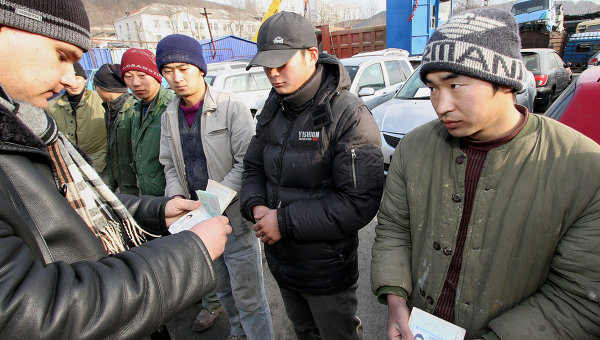
Radicalization of Migrant Workers in Russia Could Threaten Stability in Tajikistan
Publication: Eurasia Daily Monitor Volume: 10 Issue: 146
By:

On July 19, General Dzhurakhon Zoirov, head of Tajikistan’s Anti-Organized Crime Division of the Ministry of the Interior, announced that Amriddin Tabarov (a.k.a. Dumullo Amriddin) has been placed on Interpol’s international wanted list (Ozodi, July 20). Tabarov is purportedly the leader of Jamaat Ansarullah an extremist group accused of being behind a 2010 suicide bombing in Khujand and involved in the fighting that took place in the Karategin Valley the same year (see EDM, September 25, 2012).
Amriddin Tabarov is believed to be 60 years old and was born in the village of Ghulomon in the district of Nurobod. He studied in Egypt before moving to Afghanistan in 1993, from where he fought alongside the United Tajik Opposition (UTO) in Tajikistan’s civil war (Tajik IRIB, July 20). He was reportedly involved in a 1993 attack on a Russian border outpost on the Tajikistani-Afghan border, which resulted in 25 deaths. Some sources indicate that he fought with the UTO until 1997 when he left the coalition after rejecting the terms of the peace agreement between the UTO and government forces (Ozodi, July 20). However, according to Mahmadali Hayit, deputy director of the Islamic Renaissance Party of Tajikistan (IRPT), Tabarov left the UTO in 1994 because of differences of opinion with the head of the UTO, Sayid Abdullah Nuri, and one of its key commanders, Rizvon Sodirov (Nahzat, July 23).
After leaving the UTO, Tabarov linked up with Islamic Movement of Uzbekistan (IMU) in Afghanistan. Accounts differ as to how long he fought with the IMU, but according to Radio Free Europe’s Tajik service, Tababarov only spent a year with the IMU before joining the militant organization Jamaat Takfir in Pakistan (Ozodi, July 20). In 1998, his son was killed by Pakistani security services. Since then he moved between Afghanistan and Pakistan where he is thought to currently be based.
Jamaat Ansarullah is believed to have close ties with both the IMU and the Taliban; however some opposition activists question the group’s existence (see EDM, May 8, 2012). While the group has not successfully attacked Tajikistan since 2010, they have been actively recruiting members via their webpage, www.irshod.com, and through Twitter. The website features daily coverage of global Salafi-jihadist causes, updates on militant attacks on coalition forces in Afghanistan, as well as more locally geared content, such as a July 27 open letter to the Turajonzoda brothers—Haji Akbar, Nuriddin and Mahmudjon (prominent Tajikistani clerics)—on the necessity of jihad, as well as a letter addressed to Tajikistan’s parliament last October urging them not to extend Russia’s military basing rights in the country (https://irshod.com/index.php?newsid=752). The effects of such propaganda are hard to quantify, however. According to Interior Minister Ramazon Rahimov, 11 members of Jamaat Ansarullah have been arrested so far this year (BBC Tajik, July 19).
In addition to Ansarullah, on July 17, a court in Asht district in Northern Tajikistan arrested three alleged members of the group Jundallah. According to Sharif Qurbonov, Sughd Province’s chief prosecutor, one of the detained, Adham Abdolloev, had been trained in Waziristan where he was then sent to Russia to recruit more members from among the large population of Central Asian migrant workers (Asia-Plus, July 17; Ozodagon, July 19).
Far to the south in Qubodiyon district, in July, authorities announced that in the last six months 21 youths have been arrested under suspicion of being members of banned extremist organizations. The majority of the suspects hailed from the ethnically Uzbek village of Qizilnishon and were accused of being members of the IMU. In the past three years, Qubodiyon district and the village of Qizilnishon, in particular, have come under increased scrutiny by the security services, and as many as 40 members of the IMU have been arrested. Similar to the Jundallah case, prosecutors claim that many of the detained were radicalized in Russia while working abroad (BBC Tajik, July 11; Ozodagon, July 20).
In many of the recent terrorism cases in Tajikistan, prosecutors have alleged a nexus between Pakistani-based militant groups like the IMU, Jamaat Ansurallah and Jundallah, and the large Tajikistani migrant labor community in Russian. Given the corruption and politicization of Tajikistan’s judicial system, such claims are hard to verify. However, religious experts, such as Abdulloh Rahnamo, an analyst with the Strategic Analytic Center at the Office of the President, plausibly cite the difficult life of Tajikistani migrant laborers as a contributing factor to their radicalization in Russia (BBC Tajik, July 5). A combination of poverty, alienation and social discrimination on the one hand, as well as the relative religious and political freedom in Russia, create the conditions for radicalization.
In 2010, fears of radicalization abroad motivated President Emomalii Rahmon to recall students studying at madrassas in Pakistan, Iran and Saudi Arabia (Tajik IRIB, July 11). While this policy has been fairly successful in controlling the flow of Tajikistanis to Muslim countries, Tajikistan is far too economically reliant on remittances to attempt to stem the flow of migrant laborers to Russia. The radicalization of the guest workers in Russia is especially dangerous for Tajikistan if those recruited into extremist groups were to become involved (or to even to be perceived as being involved in) attacks on Russian soil (BBC Tajik, July 5). One or two high-profile cases of terrorism involving citizens of Tajikistan could heighten the already considerable tensions between Russians and the migrant community, leading to an immigration crackdown. Such a crackdown would have a direct effect on Tajikistan’s economy and social fabric, exacerbating the existing centrifugal forces, which threaten the country’s stability.




